Revealing Hidden Local Cultural Heritage through a Serious Escape Game in Outdoor Settings
Abstract
1. Introduction
2. A Brief Field Review
2.1. Cultural Heritage and Games
2.2. Serious Games
Serious Games in Cultural Heritage
2.3. Escape Rooms
2.4. Serious Escape Games
3. Game Description and Implementation
3.1. The Game
3.2. Objectives and Learning Process
3.3. The Hybrid Reality Environment
3.4. Theme
3.5. Structure and Implementation
3.6. Objects, Clues and Rewards
3.7. Objects’ Role and Players’ Actions
4. Testing and Evaluation
4.1. Research Questions, Methodology and Tools
- What are the impacts of the Serious Escape Game on team’s behavior?
- Is it and to what extent accepted by players/visitors?
- Can it and to what extent positively affect players’ attitudes toward local cultural heritage?
4.2. Participant’s Profile
4.3. Process
- Preparation and testing. The preparation and testing stage aimed to setup the game, to ensure player’s safety and the smooth operation of the AR application according to other research guidelines [4,9,25]. More specifically, preparation and testing lasted 5 days and special emphasis was given on the safety of the players. The play area was cleaned, leaves and broken tree branches were removed. Next, the spots where the objects would be hidden and the spots where the digital app would be activated were selected. The AR application was extensively tested in order to ensure its smooth operation, to select the most suitable and safe search area and to ensure enough space for comfortable players movements and the successful image recognition, because in the external environment the light brightness changes at different times of the day.
- Players invitation. Players were initially informed about the purpose of the study, the game content, the game evaluation and about the playing options and then they were invited to take part in the game. More specifically, they were offered the opportunity to choose the day and time of the event and to form the teams themselves or to play the game as one single team. The limitations were that the number of members of each team should not exceed six people. In most games, teams have five players or more [3]; however, for the settings of the specific game (available space, number of items and quizzes), a team with more members was not considered to be an effective choice. Another limitation was the weather conditions, which should not restrict game conduction and there should be daylight for the application to be used. There was a very positive response and willingness to participate, so after the invitation there were immediate appointments for the day and time of play.
- Game conduction (Figure 6). The game conduction stage provided a test with players in real conditions and aimed to study this type of game, the players’ reactions and attitudes toward the game and the local cultural heritage and to identify possible problems, failures, etc. that were not predicted during game development. There were two game plays, with two teams competing in each play. Players were introduced to the purpose, the goal, and the rules of the game. Grouping into two teams was done by the players themselves. Players were also asked to choose whether they wanted to compete based on a time limit or on the best time. All players decided to compete for the best time. The first two teams had already decided the grouping, and both teams had the same number of players. The 3rd and 4th teams were formed just before the play. All teams decided the order of participation themselves. Before the game each team was given instructions about the purpose of the game (search for a hidden secret by solving puzzles), about the use of the application and about the area where they should search for clues. During the play, the opposing team waited its turn at another spot, without visual or acoustic contact with the game area. The players were supervised by the researcher who was present in the place the game was conducted and had the role of the game master, first of all to ensure players safety, to guide and help them in case they got stuck or disappointed by providing hints, to provide feedback and guidance in certain cases such as when looking for items outside the area or confirmation if an object was a clue for the solution of the puzzle and to ensure the smooth flow of the game, according to relevant study findings and guidelines [4,9].
- Game evaluation. The game evaluation stage included initially a group semi-structured interview and then the debriefing-reflection phase (Figure 7). In the end of each play, a group semi-structured interview was conducted, which lasted 20–30 min and only written notes were kept. The debriefing-reflection phase is considered an important element [32] and in the current study aimed to study the views and experience of players with the game, local history, and local cultural heritage. The debriefing-reflection phase with the players lasted 15–20 min, where the researcher-instructor explained the purpose of the game, how the game was organized with the first priority being the safety of the players, what elements were used, how the documentation of the historical data was done (residents’ interviews, etc.), the use of stop motion technique for the myth’s representation and the AR application development. Debriefing-reflection is considered a critical component that leads to long-term learning, to better experience and to game improvement [3,4,9]. In the current study it was additionally used as an evaluation tool. Evaluation of learning outcomes was conducted in an indirect way, through interviews and discussion and not by a formal form like a test, which was considered inappropriate in this preliminary phase of the game.
5. Evaluation Results
5.1. Impact on Team’s Behavior/Teams’ Dynamics and Cohesion
5.2. Attitude Toward the Game
5.3. Attitude Toward Local Cultural Heritage
6. Discussion and Conclusions
- regarding the impact of the Serious Escape Game on team’s behavior (research question 1), it is noticed that the game experience had positive effects and offered players multiple and valuable benefits such as new knowledge, teamwork, collaboration, enjoyment, motivation, interest etc., corresponding to learning outcomes and skills enhancement and improvement reported in other surveys [3,10,20,23,24] and therefore confirming their results. Additionally, it was found that the friendly competition between the two teams helped players to immerse in the activity and the given ability to players to decide how to play allowed them to engage with the game in their own way, confirms the results and guidelines of other studies [4,9].
- the positive and immediate response to participation, the positive attitude during the game and the positive comments of the players after the end of the game are in line with the results of other surveys [2] and indicate that this category of games can be accepted to a large extent by the players/visitors (research question 2).
- the players’ positive attitude, enthusiasm and interest about the local history and cultural heritage and their determination to overcome difficulties of the natural environment are in line with the findings of other studies [20]. Additionally, their positive behavior and attitude indicate respect both for the game and for the space, in contrast to cases of damages in the room caused by players [4] and therefore this type of game can positively affect players’/visitors’ attitudes toward local cultural heritage (research question 3).
Author Contributions
Funding
Institutional Review Board Statement
Informed Consent Statement
Data Availability Statement
Conflicts of Interest
Appendix A
List of Questions
- Players age and main occupation (asked to select one of the following: pupil, student, other)
- Do you often visit the village?
- Do you know any historical information about the place? If so, how did you learn about it?
- Have you ever played escape room games?
- How interesting did you find the game?” (please select one of the following: “not at all”, “a little”, “moderate”, “very” and “extremely”)
- What did you like about the game?
- What didn’t you like about the game?
- Do you have any comments or suggestions you would like to make about the game?
- Have you used any AR application? if so, could you please mention one?
- What would you like to comment on the content of the AR application?
- What is your opinion about the representation of the myth?
- Do you believe that this representation is intended only for young children, that is more suitable for a certain age group and specifically only for preschool children?
- How much did you like the combination of culture and technology?
- Would you like similar experiences to be available for this area?
- How would you describe the overall experience?
References
- Ćosović, M.; Brkić, B.R. Game-Based Learning in Museums—Cultural Heritage Applications. Information 2020, 11, 22. [Google Scholar] [CrossRef]
- Borrego, C.; Fernández, C.; Blanes, I.; Robles, S. Room escape at class: Escape games activities to facilitate the motivation and learning in computer science. J. Technol. Sci. Educ. 2017, 7, 162–171, ISSN 2013-6374. [Google Scholar] [CrossRef]
- Fotaris, P.; Mastoras, T. Escape Rooms for Learning: A Systematic Review. In Proceedings of the 13th International Conference on Game Based Learning, ECGBL; Elbaek, L., Majgaard, G., Valente, A., Khalid, S., Eds.; Academic Conferences and Publishing International Limited: Reading, UK, 2019; pp. 235–243. [Google Scholar] [CrossRef]
- Nicholson, S. Peeking Behind the Locked Door: A Survey of Escape Room Facilities. White Paper. 2015. Available online: http://scottnicholson.com/pubs/erfacwhite.pdf (accessed on 20 September 2020).
- Malegiannaki, I.; Daradoumis, T. Analyzing the educational design, use and effect of spatial games for cultural heritage: A literature review. Comput. Educ. 2017, 108, 1–10, ISSN 0360-1315. [Google Scholar] [CrossRef]
- Dimitropoulos, K.; Tsalakanidou, F.; Nikolopoulos, S.; Kompatsiaris, I.; Grammalidis, N.; Manitsaris, S.; Denby, B.; Crevier-Buchman, L.; Dupont, S.; Charisis, V.; et al. A Multimodal Approach for the Safeguarding and Transmission of Intangible Cultural Heritage: The Case of i-Treasures. IEEE Intell. Syst. 2018, 33, 3–16. [Google Scholar] [CrossRef]
- Hautaniemi, A. Combining Games and Cultural Heritage Gamified Experiences Can Help Youth Engagement in Joint History. In Smart Business Annual Review; Sallinen, N., Kotonen, U., Eds.; Painopaikka: Hämeenlinna, Finland, 2019; pp. 56–62. ISBN 978-951-827-316-8. [Google Scholar]
- Yang, Y.; Zhang, D.; Ji, T.; Li, L.; He, Y. Designing Educational Games Based on Intangible Cultural Heritage for Rural Children: A Case Study on “Logic Huayao”. In Advances in Human Factors in Wearable Technologies and Game Design. AHFE 2018. Advances in Intelligent Systems and Computing; Ahram, T., Ed.; Springer: Cham, Switzerland, 2018; Volume 795. [Google Scholar] [CrossRef]
- Guigon, G.; Humeau, J.; Vermeulen, M. A Model to Design Learning Escape Games: SEGAM. In Proceedings of the 10th International Conference on Computer Supported Education (CSEDU 2018); SCITEPRESS: Funchal, Madeira, Portugal, 2018; Volume 2, pp. 191–197. ISBN 978-989-758-291-2. [Google Scholar]
- Warmelink, H.; Mayer, I.; Weber, J.; Heijligers, B.; Haggis, M.; Peters, E.; Max Louwerse, M. AMELIO: Evaluating the Team-building Potential of a Mixed Reality Escape Room Game. In Extended Abstracts Publication of the Annual Symposium on Computer-Human Interaction in Play; ACM: New York, NY, USA, 2017; pp. 111–123. [Google Scholar] [CrossRef]
- Antoniou, A. Predicting Cognitive Profiles from a Mini Quiz: A Facebook Game for Cultural Heritage. In Games and Learning Alliance. GALA 2018. Lecture Notes in Computer Science; Gentile, M., Allegra, M., Söbke, H., Eds.; Springer: Cham, Switzerland, 2018; Volume 11385. [Google Scholar] [CrossRef]
- Paliokas, I.; Sylaiou, S. A Classification Model for Serious Games Used in Museums, Galleries and Other Cultural Sites. In Strategic Innovative Marketing and Tourism. In Proceedings in Business and Economics; Kavoura, A., Kefallonitis, E., Giovanis, A., Eds.; Springer: Cham, Switzerland, 2019; pp. 1057–1064. [Google Scholar] [CrossRef]
- Lu, Z.; Annett, M.; Fan, M.; Wigdor, D. I feel it is my responsibility to stream”: Streaming and Engaging with Intangible Cultural Heritage through Livestreaming. In Proceedings of the 2019 CHI Conference on Human Factors in Computing Systems (CHI ‘19), Glasgow, Scotland, UK, 4–9 May 2019; Association for Computing Machinery: New York, NY, USA, 2019; pp. 1–14. [Google Scholar] [CrossRef]
- Hanes, L.; Stone, R. Applying constrained virtual environments to serious games for heritage. Int. J. Serious Games 2019, 6, 93–116. [Google Scholar] [CrossRef]
- Panou, C.; Ragia, L.; Dimelli, D.; Mania, K. An Architecture for Mobile Outdoors Augmented Reality for Cultural Heritage. ISPRS Int. J. Geo-Inf. 2018, 7, 463. [Google Scholar] [CrossRef]
- Vocaturo, E.; Zumpano, E.; Caroprese, L.; Pagliuso, S.M.; Lappano, D. Educational Games for Cultural Heritage. In Proceedings of the 1st International Workshop on Visual Pattern Extraction and Recognition for Cultural Heritage Understanding Co-Located with 15th Italian Research Conference on Digital Libraries (IRCDL 2019) CNR Area in Pisa, Pisa, Italy, 30 January 2019; Volume 2320, pp. 95–106. [Google Scholar]
- Di Paola, F.; Inzerillo, L.; Alognaa, Y. A GAMING APPROACH FOR CULTURAL HERITAGE KNOWLEDGE AND DISSEMINATION. In Proceedings of the Int. Arch. Photogramm. Remote Sens. Spatial Inf. Sci., XLII-2/W15, 27th CIPA International Symposium “Documenting the Past for a Better Future”, Ávila, Spain, 1–5 September 2019; pp. 421–428. [Google Scholar] [CrossRef]
- Koo, S.; Kim, J.; Kim, C.; Kim, J.; Cha, H.S. Development of an Augmented Reality Tour Guide for a Cultural Heritage Site. J. Comput. Cult. Herit 2019, 12, 4. [Google Scholar] [CrossRef]
- Polyakova, I.R.; Maglieri, G.; Mirri, S.; Salomoni, P.; Mazzeo, R. Art Scene Investigation: Discovering and supporting cultural heritage conservation through Mobile AR. In Proceedings of the IEEE INFOCOM 2019-IEEE Conference on Computer Communications Workshops (INFOCOM WKSHPS), Paris, France, 29 April–2 May 2019; pp. 584–589. [Google Scholar] [CrossRef]
- Koutroumanos, G.; Labropoulos, G. “Salamis”: A location augmented reality game for local history. In Proceedings of the 11th Pan-Hellenic and International Conference “ICT in Education”, Thessaloniki, Greece, 19–21 October 2018; Demetriadis, S., Dagdilelis, V., Tsiatsos, T., Magnisalis, I., Tzimas, D., Eds.; AUTh–UOM: Thessaloniki, Greece, 2018; pp. 355–362. ISBN 978-618-83186-2-5. [Google Scholar]
- Shin, J.; Kim, J.; Woo, W. Narrative design for Rediscovering Daereungwon: A location-based augmented reality game. In Proceedings of the IEEE International Conference on Consumer Electronics (ICCE), Las Vegas, NV, USA, 8–11 January 2017; pp. 384–387. [Google Scholar] [CrossRef]
- Haahr, M. Creating Location-Based Augmented-Reality Games for Cultural Heritage. In Serious Games. JCSG 2017. Lecture Notes in Computer Science; Alcañiz, M., Göbel, S., Ma, M., Fradinho Oliveira, M., Baalsrud Hauge, J., Marsh, T., Eds.; Springer: Cham, Switzerland, 2017; Volume 10622, pp. 313–318. [Google Scholar] [CrossRef]
- Nofal, E.; Panagiotidou, G.; Reffat, R.M.; Hameeuw, H.; Boschloos, V.; Vande Moere, A. Situated Tangible Gamification of Heritage for Supporting Collaborative Learning of Young Museum Visitors. ACM J. Comput. Cult. Herit. 2020, 13, 3. [Google Scholar] [CrossRef]
- Mortara, M.; Catalano, C.E.; Bellotti, F.; Fiucci, G.; Houry-Panchetti, M.; Petridis, P. Learning cultural heritage by serious games. J. Cult. Herit. 2014, 15, 318–325, ISSN 1296-2074. [Google Scholar] [CrossRef]
- Mortara, M.; Catalano, C.E. 3D virtual environments as effective learning contexts for cultural heritage. Ital. J. Educ. Technol. 2018, 26, 5–21. [Google Scholar] [CrossRef]
- What Are Serious Games? Growth Engineering Ltd. Available online: https://www.growthengineering.co.uk/what-are-serious-games/ (accessed on 15 July 2020).
- Isa, W.M.W.; Zin, N.A.M.; Rosdi, F.; Sarim, H.M. Serious Game Design for Terengganu Brassware Craft Heritage. In Proceedings of the IEEE Conference on Graphics and Media (GAME), Pulau Pinang, Malaysia, 19–21 November 2019; pp. 13–17. [Google Scholar] [CrossRef]
- Yallihep, M.; Kutlu, B. Mobile serious games: Effects on students’ understanding of programming concepts and attitudes towards information technology. Educ. Inf. Technol. 2020, 25, 1237–1254. [Google Scholar] [CrossRef]
- Tsita, C.; Satratzemi, M. How serious games in cultural heritage are being evaluated. In Proceedings of the 11th Pan-Hellenic and International Conference “ICT in Education”, Thessaloniki, Greece, 19–21 October 2018; Demetriadis, S., Dagdilelis, V., Tsiatsos, T., Magnisalis, I., Tzimas, D., Eds.; AUTh–UOM: Thessaloniki, Greece, 2018; pp. 97–104. ISBN 978-618-83186-2-5. [Google Scholar]
- Georgopoulos, A.; Kontogianni, G.; Koutsaftis, C.; Skamantzari, M. Serious Games at the Service of Cultural Heritage and Tourism. In Tourism, Culture and Heritage in a Smart Economy; Katsoni, V., Upadhya, A., Stratigea, A., Eds.; Springer: Cham, Switzerland, 2017. [Google Scholar] [CrossRef]
- Konstantakis, M.; Caridakis, G. Adding Culture to UX: UX Research Methodologies and Applications in Cultural Heritage. ACM J. Comput. Cult. Herit. 2020, 13, 4. [Google Scholar] [CrossRef]
- Clarke, S.J.; Peel, D.J.; Arnab, S.; Morini, L.; Keegan, H.; Wood, O. EscapED: A Framework for Creating Educational Escape Rooms and Interactive Games to For Higher/Further Education. Int. J. Serious Games 2017, 4. [Google Scholar] [CrossRef]
- Georgoulas, S. Platanoussa. Epirotiki Estia 1973, 256–258, 500–510. [Google Scholar]
- Tzima, S.; Styliaras, G.; Smyris, G.; Bassounas, A. Digital Representations and Cultural Heritage Interactions Through the “Greek Type” Watermills Case. In Proceedings of the 2018 9th International Conference on Information, Intelligence, Systems and Applications (IISA), Zakynthos, Greece, 23–25 July 2018. [Google Scholar]
- Tzima, S.; Styliaras, G.; Zaragas, H.; Bassounas, A. The Effects of an Educational Augmented Reality Application on the Interpretation and Communication of Cultural Assets: The “Greek Type” Watermill’s Case. In Proceedings of the EdMedia + Innovate Learning, Amsterdam, The Netherlands, 25 June 2018; Association for the Advancement of Computing in Education (AACE): Waynesville, NC, USA, 2018. [Google Scholar]
- Tzima, S.; Styliaras, G.; Bassounas, A.; Tzima, M. Harnessing the Potential of Storytelling and Mobile Technology in Intangible Cultural Heritage: A Case Study in Early Childhood Education in Sustainability. Sustainability 2020, 12, 9416. [Google Scholar] [CrossRef]
- Tzima, S.; Tzima, M. Stone and wood. Tzoumerkiotika. Chronika 2020, 21, 75–77. [Google Scholar]
- Issari, P.; Pourkos, M. Qualitative Research Methodology; Hellenic Academic Libraries Link: Athens, Greece, 2015; pp. 83, 97, 111–112. Available online: http://hdl.handle.net/11419/5826 (accessed on 20 July 2020).
- Cohen, L.; Manion, L.; Morrison, K. Research Methods in Education, 6th ed.; Routledge: London, UK, 2007; p. 475. [Google Scholar]
- Hughes, A. Gamification versus Serious Games. LEARNING TECHNOLOGIES, 7 September 2017. Available online: https://trainingindustry.com/articles/learning-technologies/gamification-versus-serious-games/ (accessed on 8 May 2019).
- Tzima, S.; Styliaras, G.; Bassounas, A. Augmented Reality in Outdoor Settings: Evaluation of a Hybrid Image Recognition Technique. J. Comput. Cult. Herit. under publication.
- Fokides, E.; Atsikpasi, P.; Kaimara, P.; Deliyannis, I. Factors influencing the subjective learning effectiveness of serious games. J. Inf. Technol. Educ. Res. 2019, 18, 437–466. [Google Scholar] [CrossRef]
- Perttula, A.; Kiili, K.; Lindstedt, A.; Tuomi, P. Flow experience in game based learning—A systematic literature review. Int. J. Serious Games 2017, 74, 57–72. [Google Scholar] [CrossRef]
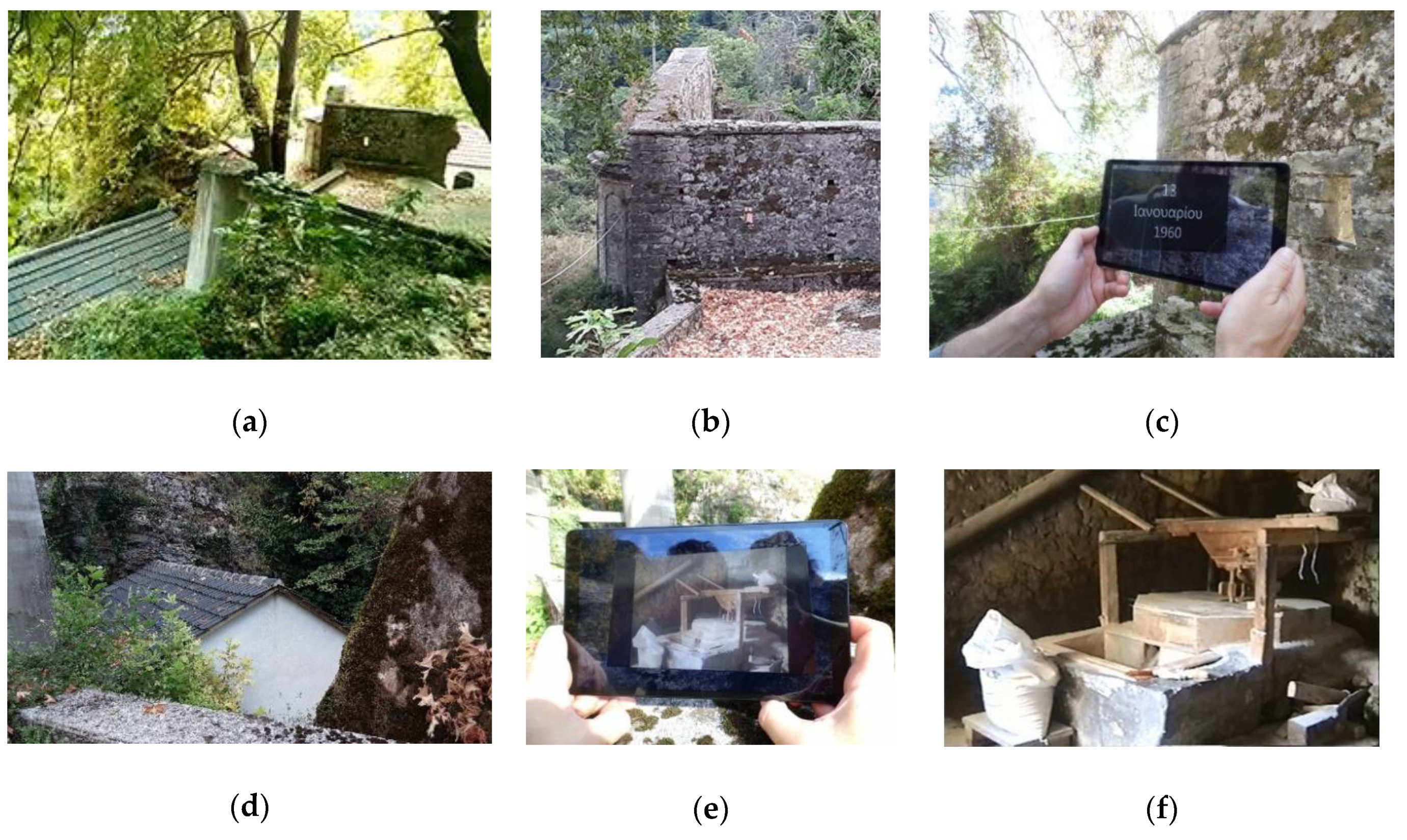
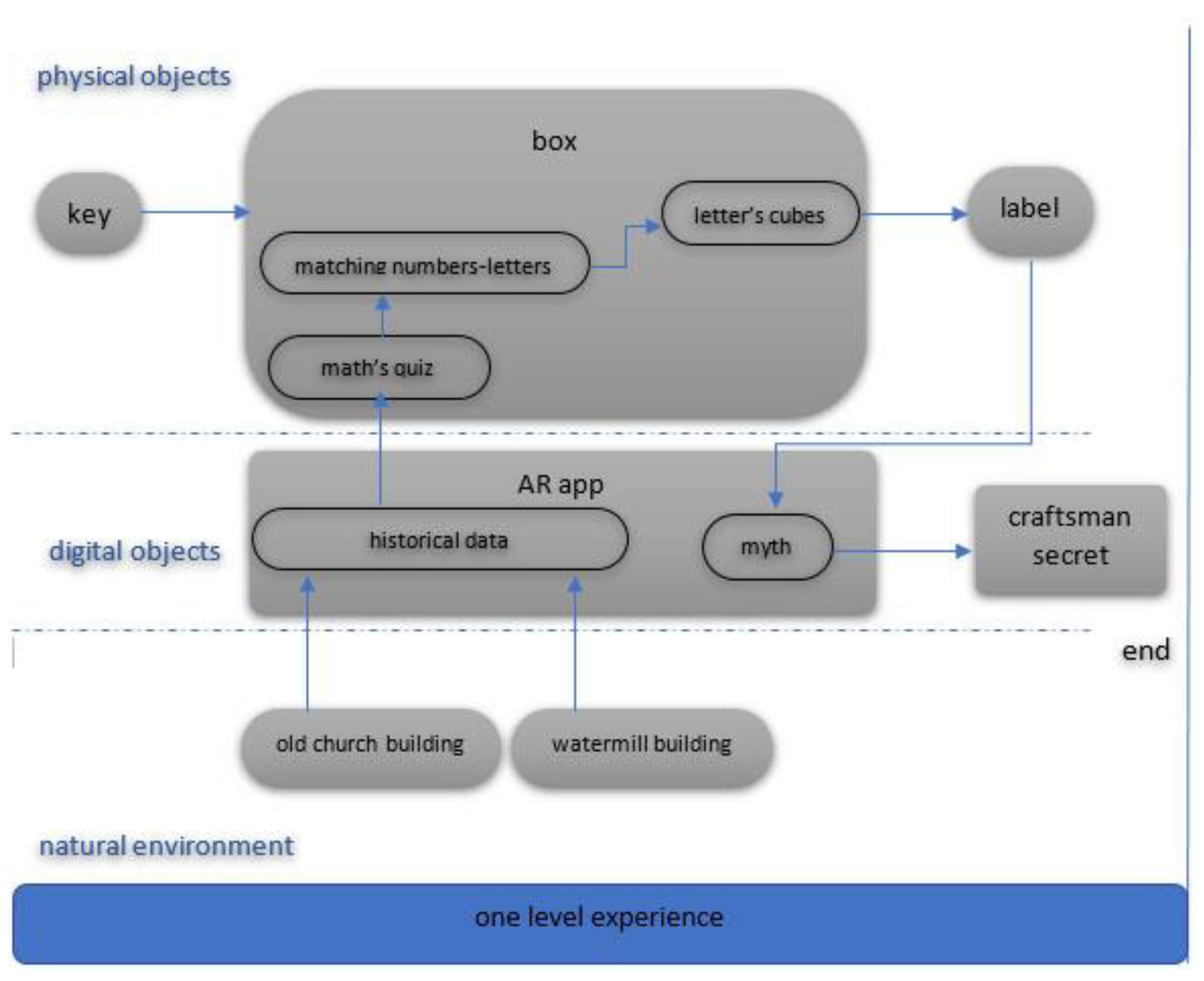
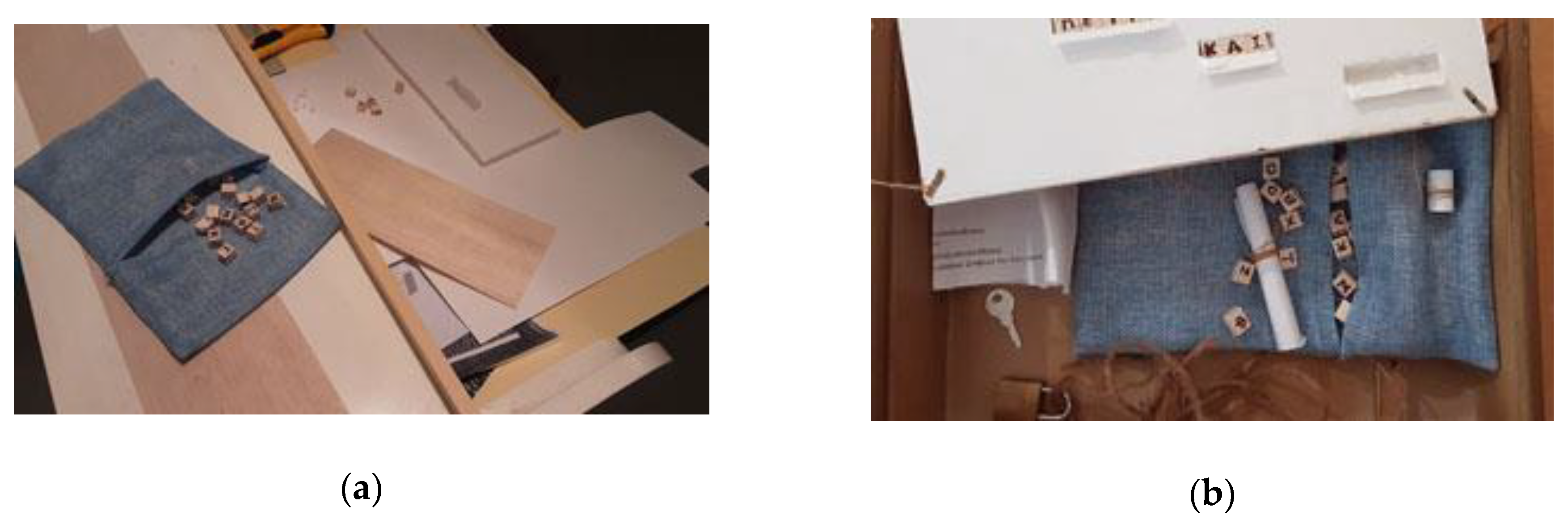

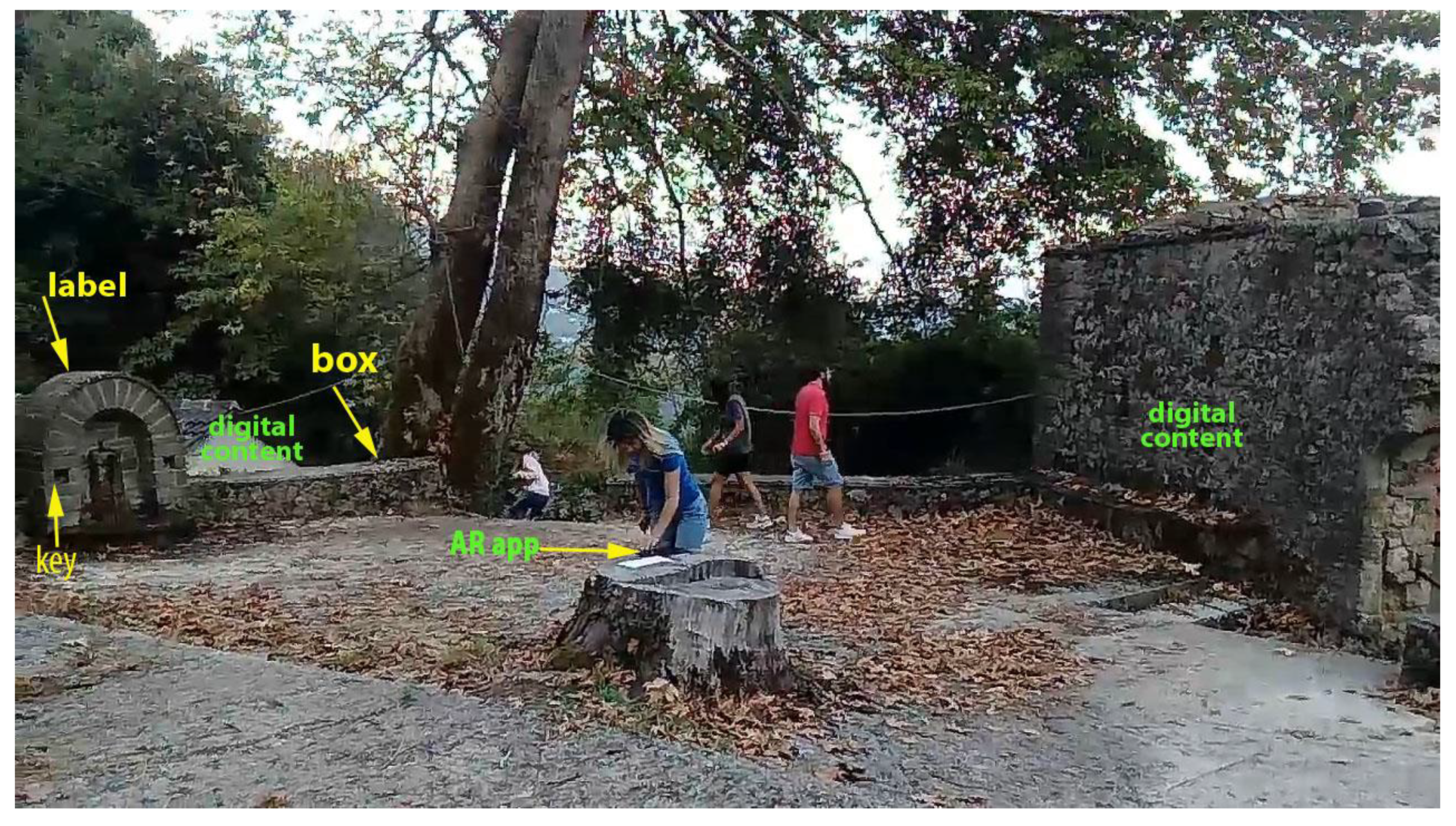
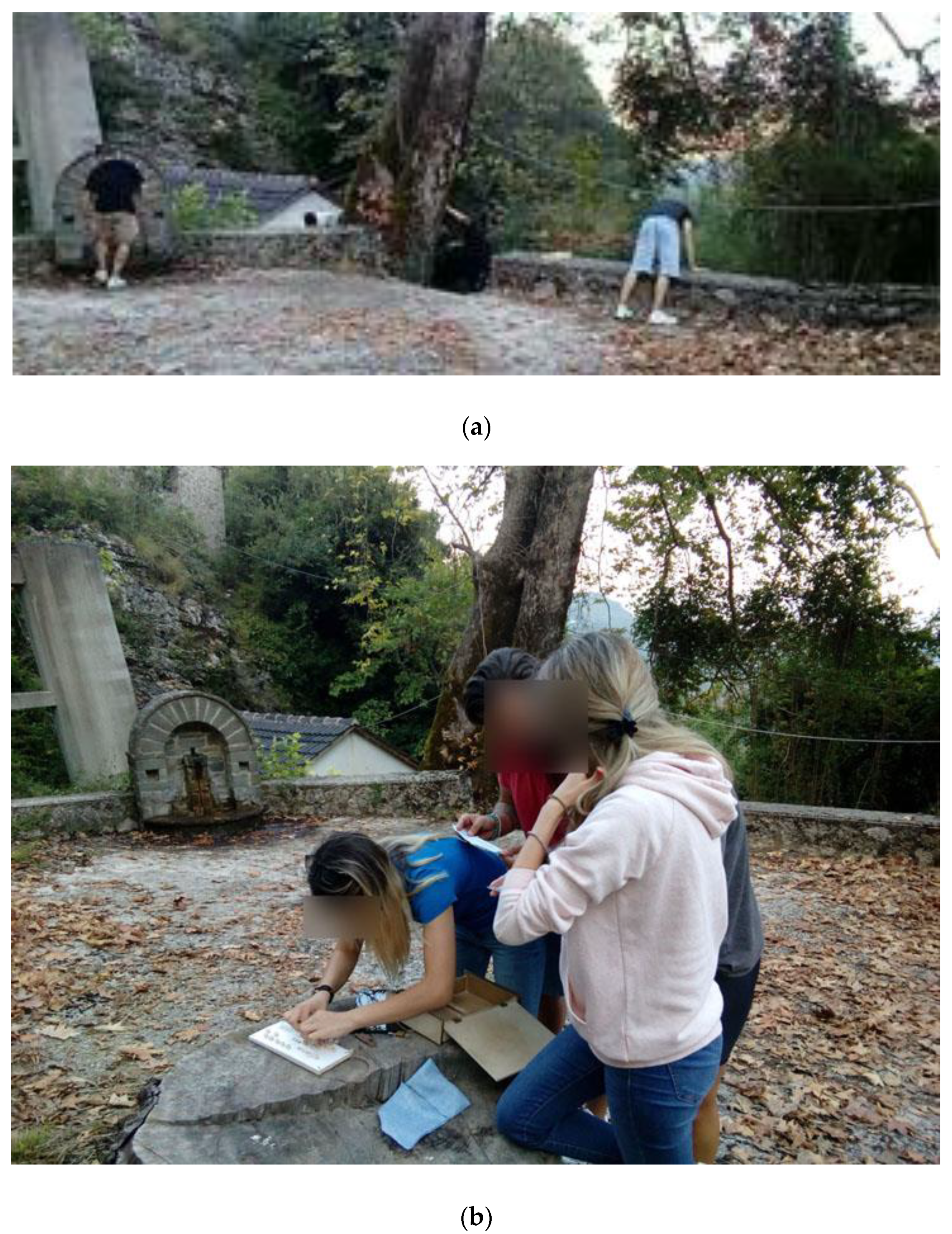

Publisher’s Note: MDPI stays neutral with regard to jurisdictional claims in published maps and institutional affiliations. |
© 2020 by the authors. Licensee MDPI, Basel, Switzerland. This article is an open access article distributed under the terms and conditions of the Creative Commons Attribution (CC BY) license (http://creativecommons.org/licenses/by/4.0/).
Share and Cite
Tzima, S.; Styliaras, G.; Bassounas, A. Revealing Hidden Local Cultural Heritage through a Serious Escape Game in Outdoor Settings. Information 2021, 12, 10. https://doi.org/10.3390/info12010010
Tzima S, Styliaras G, Bassounas A. Revealing Hidden Local Cultural Heritage through a Serious Escape Game in Outdoor Settings. Information. 2021; 12(1):10. https://doi.org/10.3390/info12010010
Chicago/Turabian StyleTzima, Stavroula, Georgios Styliaras, and Athanasios Bassounas. 2021. "Revealing Hidden Local Cultural Heritage through a Serious Escape Game in Outdoor Settings" Information 12, no. 1: 10. https://doi.org/10.3390/info12010010
APA StyleTzima, S., Styliaras, G., & Bassounas, A. (2021). Revealing Hidden Local Cultural Heritage through a Serious Escape Game in Outdoor Settings. Information, 12(1), 10. https://doi.org/10.3390/info12010010





